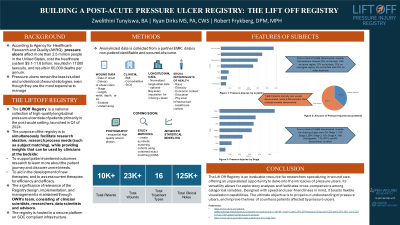Clinical Research
(CR-059) Building a Post-Acute Pressure Ulcer Registry: The Lift Off Registry

A Pressure Ulcer Registry is crucial due to the limited focus on this prevalent and debilitating healthcare issue. Pressure ulcers, affect millions of patients worldwide, leading to pain, prolonged hospital stays, and significant healthcare costs. Yet, they remain poorly studied, with fragmented data and inconsistent reporting. A dedicated registry would centralize information on pressure ulcers, offering a comprehensive view of incidence, risk factors, prevention strategies, and treatment outcomes. By shedding light on this underrepresented area, the Lift Off Registry facilitates improves clinical research, evidence-based practices, enhances patient care, and contributes to reducing the burden global burden of pressure ulcers.
Methods:
In a collaborative effort, Open Wound Research forged a partnership with United Wound Healing, a large post-acute wound care consultancy, to procure high-quality longitudinal data related to pressure ulcers for the Lift Off Registry. This comprehensive dataset underwent an anonymization process, ensuring patient privacy while facilitating data analysis. Data cleanliness and standardization procedures were meticulously applied, enhancing the accuracy and reliability of the information. To provide dynamic descriptive insights, variables were dynamically enriched. The securely anonymized data found its repository in a state-of-the-art Data Lakehouse, and a presentation layer was created using a leading dashboarding solution.
Results: The Lift Off Registry encompasses a substantial dataset, featuring records of approximately 10,000 patients, accounting for 18,000 pressure ulcers, complete with longitudinal data and a myriad of categorical and temporal variables.
Discussion:
The Lift Off Registry is an invaluable resource for researchers specializing in wound care, offering an unparalleled opportunity to delve into the intricacies of pressure ulcers. Its versatility allows for exploratory analyses and facilitates cross-comparisons among categorical variables. Designed with speed and user-friendliness in mind, it boasts flexible visualization capabilities. The ultimate objective is to propel our understanding of pressure ulcers, and improve the lives of countless patients affected by pressure ulcers.

.jpeg)